Alright, let’s dive deep into the mysterious and mesmerizing world of the orca, or as some like to call them, killer whales. These majestic creatures have captured our imaginations and have often been the stars of myths and legends. But what’s the real deal with these iconic sea mammals?
What is the Orca?
First off, let’s set the record straight. The orca (Orcinus orca) isn’t your average whale. In fact, it’s not a whale at all in the traditional sense; it’s the largest member of the dolphin family. That’s right, these so-called “killer whales” are actually gigantic dolphins with a bad reputation and a badass name. They’re the ocean’s top predators, sitting comfortably at the top of the food chain, which basically makes them the mob bosses of the marine world.
Orca societies are complex, their hunting techniques are sophisticated, and their vocal behaviors are so advanced that scientists say they have dialects—imagine having accents, but underwater. They roam the vast oceans, from the icy waters of the Arctic and Antarctic to tropical seas, which means they’re more well-traveled than most of us could ever dream to be.
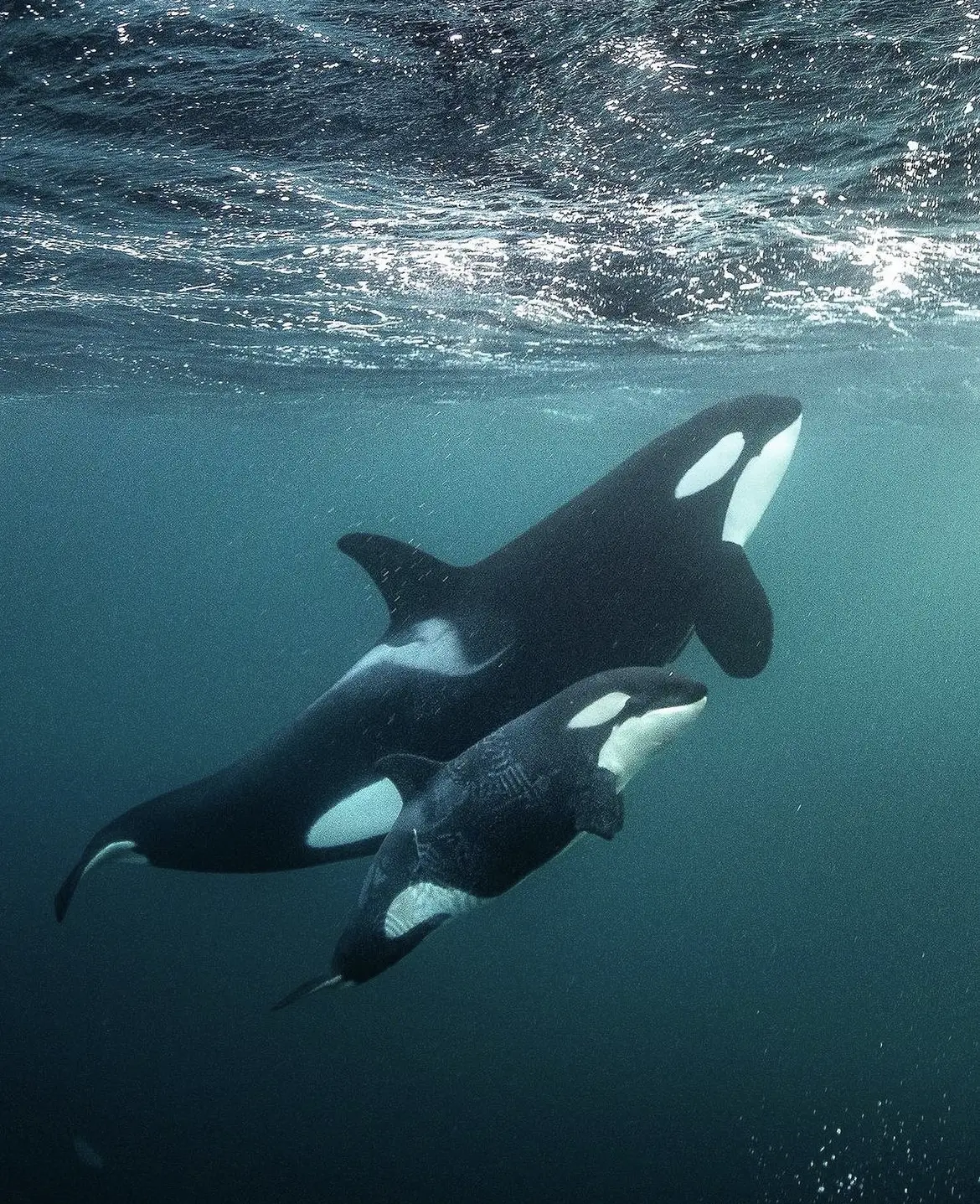
What do Killer Whales look like?
Imagine the sleekest, most imposing predator in the ocean, and you’ve got yourself an orca. These creatures are striking with their black bodies, white undersides, and distinctive white patches above their eyes. They’re like the penguins of the dolphin world but much larger and more intimidating. Male orcas boast a towering dorsal fin that can reach up to 6 feet in height—the marine equivalent of a Mohawk—making them the punk rockers of the sea.
Their bodies are built for the hunt, streamlined for speed with powerful flukes (tails) that can propel them through the water at breakneck speeds. They’ve got this look in their eyes, too—intelligent, curious, and a tad bit mischievous. It’s as if they know they’re the coolest kids in the ocean.
How big are Orcas?
When we talk about size, orcas don’t mess around. Males can grow up to 26 feet long—that’s longer than a school bus—and weigh in at a whopping 6 tons. Females are a bit smaller, usually maxing out around 23 feet and weighing less than their male counterparts, but don’t let that fool you; they’re every bit as formidable.
To put it in perspective, if you were to line up three average cars end to end, an adult male orca could pretty much match that length. And in terms of weight, think of it as stacking about four small cars on a giant seesaw. Yeah, these creatures are massive, making them the undisputed heavyweights of the marine mammal world.
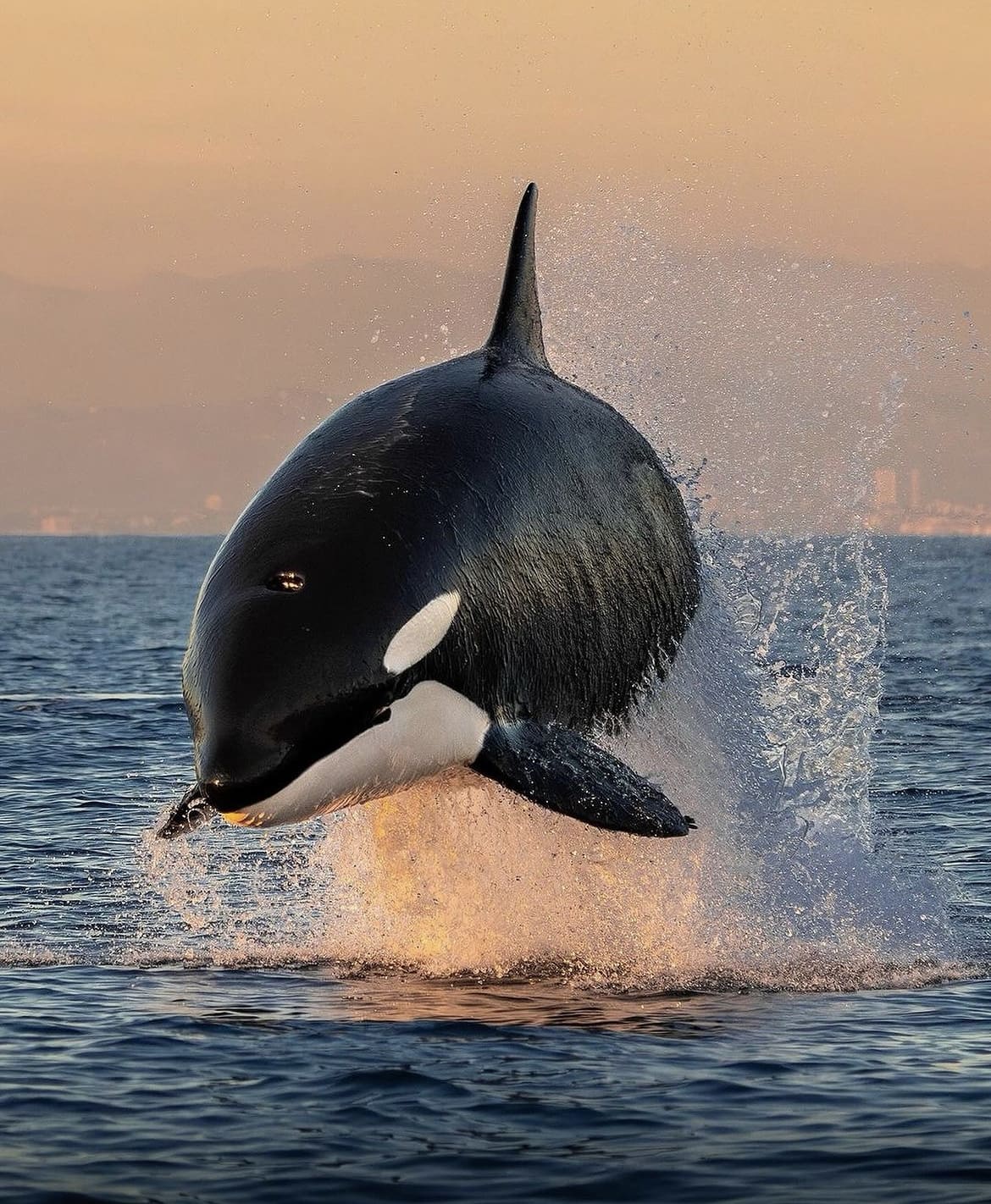
Orca Skin
First up, let’s talk about that smooth operator vibe orcas have going on. Their skin is not only sleek and shiny, making them the supermodels of the sea, but it’s also highly adapted to their lifestyle. It’s thick, rubbery, and plays a critical role in regulating their body temperature. Plus, it’s hydrodynamic, which means it reduces drag, allowing them to slice through the water with the grace of an Olympic swimmer.
But here’s a fun fact: orcas undergo a process called “skin sloughing,” which is a fancy way of saying they shed their outer layer of skin more frequently than we do. This helps them stay clean and reduce drag even further. Imagine if you could just shed your skin to get rid of a bad tattoo or a regrettable sunburn. Orcas, living the dream.
Killer Whale Teeth
Now, onto the chompers. Orca teeth are the stuff of legend—large, conical, and designed for ripping and tearing. Each tooth can be up to 4 inches long. That’s about the length of your smartphone, but way deadlier. They’ve got around 40-56 of these bad boys lined up in their jaws, ready to take on seals, fish, and sometimes even sharks. Yes, sharks. These creatures don’t mess around when it comes to mealtime.
Their teeth are not just for feeding, though. Orcas use them in social interactions, such as establishing dominance or showing affection (which, if you ask me, is a pretty hardcore way to show you care). It’s like saying, “I like you so much, I won’t use my terrifying teeth to eat you.” Romance isn’t dead, folks, it’s just underwater.
Orca breaching at sunrise | @sweet_salt_t
Orca Colouration
It’s not just for show; it plays a crucial role in their hunting strategy, known as “disruptive coloration.” This means that their colour pattern breaks up their body shape, making it harder for prey to spot them against the water’s surface. It’s like nature’s version of camo, but way cooler.
The white patches above their eyes and on their bellies serve another purpose too. They’re thought to be important for social communication among orcas. These patches can make them more visible to each other during social interactions and might help in recognizing each other. It’s like each orca wearing a unique, natural mask to the world’s most exclusive masquerade ball, where everyone’s dressed to kill—literally.
How do Killer Whales hunt?
Orcas are the ocean’s ultimate strategists, employing a variety of hunting techniques that would put the best military tacticians to shame. They’re known for their cooperative hunting strategies, where they work together like a well-oiled machine—think Ocean’s Eleven, but with fins and teeth. One of their most famous techniques is “wave washing,” where they create waves to knock seals off ice floes into the water, demonstrating their ability to manipulate their environment to their advantage.
They also use echolocation, a biological sonar, to locate and track their prey in the murky depths. This means they can emit sounds that bounce off objects, helping them “see” with sound. It’s like having built-in sonar navigation that guides them straight to their next meal. This combination of intelligence, teamwork, and biological tools makes orcas one of the most formidable predators on the planet.
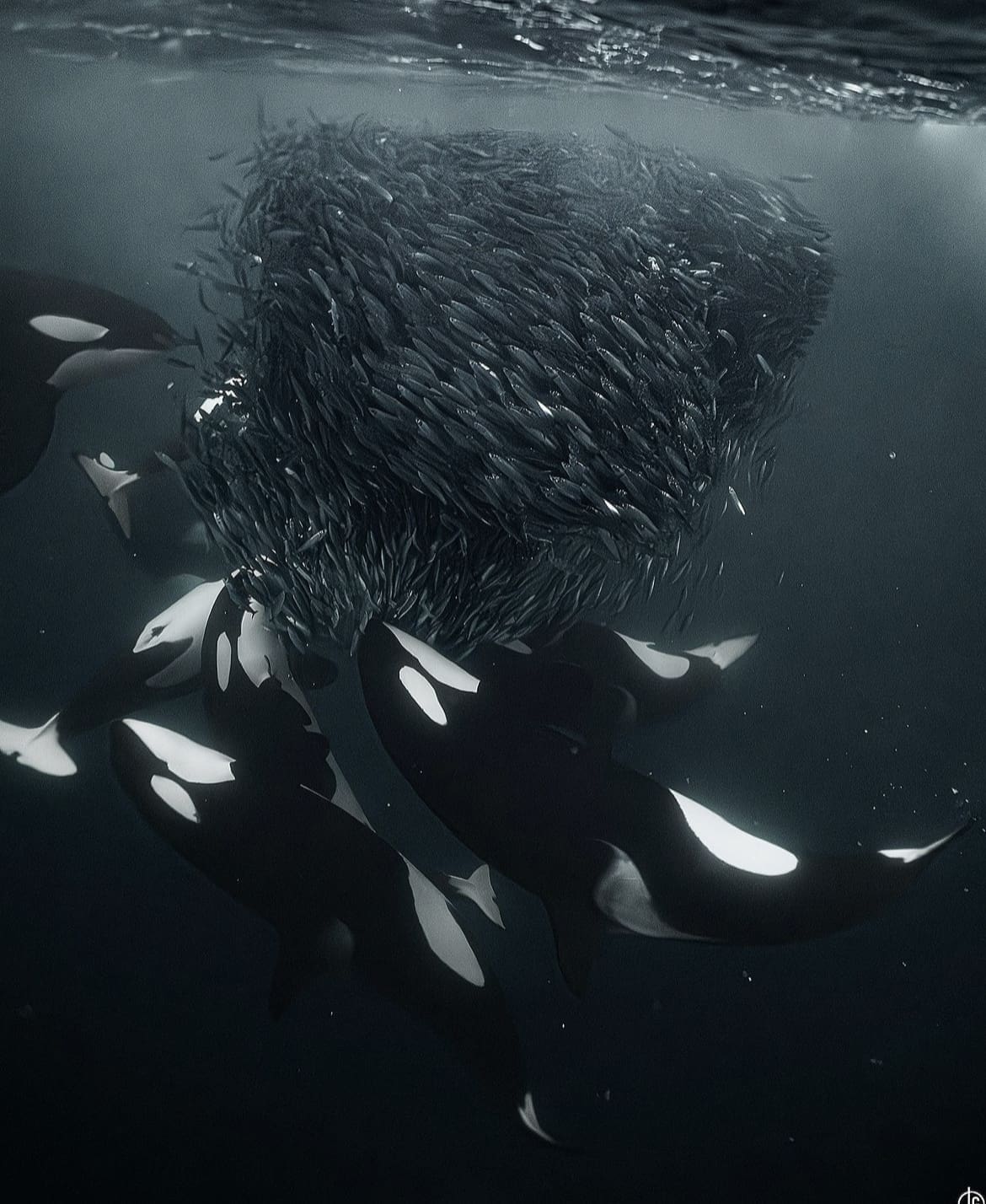
Orca social structure
Orcas are the epitome of social creatures; their societies are matriarchal, centered around the oldest and wisest female, often the grandmother. These family units, known as pods, can consist of up to 40 individuals, and they’re all about that tight-knit community vibe. Think of them as the original squad goals, where everyone looks out for each other, shares food, and even babysits the young ones.
Each pod has its own unique dialect, a set of calls and noises that are as distinct as human languages. This means that orcas can identify which pod another orca comes from just by listening to their calls. It’s like having an accent that instantly tells others about your background and where you’re from. This complex communication plays a crucial role in maintaining the social bonds that are vital to their survival.
How do Orcas reproduce?
When it comes to making baby orcas, it’s all about timing and courtship. Orcas don’t have a specific breeding season; instead, mating can happen at any time of the year. Males woo females through a series of displays and vocalizations, showcasing their strength and agility. It’s the marine version of a dance-off where the stakes are high, and only the best moves win.
Pregnancy lasts for about 17 months, leading to the birth of a single calf. These calves are born tail-first and are immediately guided to the surface by their mothers to take their first breath. It’s a tender moment that highlights the strong bond between mother and child. Calves nurse for at least a year but often remain close to their mothers for much longer, learning the ways of the pod through observation and instruction.

How long do Killer Whales live?
The lifespan of orcas is one of the most remarkable aspects of their biology. Females can live up to 90 years, while males typically live around 60 years. This longevity contributes to the depth of knowledge and experience within the pod, especially since older females act as leaders and repositories of hunting knowledge and social customs. It’s a bit like having your grandma as the CEO of the family business, guiding everyone with wisdom accumulated over decades.
These long-lived mammals showcase the importance of family ties, knowledge transmission, and social cohesion in the animal kingdom. Their lifespans allow for the development of complex social structures and deep, enduring bonds that are the backbone of orca society.
Are Orcas aggressive?
Labeling orcas as “aggressive” might bring to mind sensational headlines or dramatic scenes from wildlife documentaries. However, the reality is far more nuanced. In their natural habitat, orcas generally focus their formidable hunting skills on prey, not humans. There have been virtually no confirmed attacks on humans in the wild. Their interactions with other marine life, while predatory towards species like seals and fish, are part of the natural balance of the ecosystem.
In captivity, however, orcas can exhibit aggressive behaviors, which experts believe are a result of stress, confinement, and the frustration of not being able to perform their natural behaviors. This distinction highlights the importance of understanding orca behavior within the context of their natural environment versus human-imposed conditions.

Are Killer Whales territorial?
Unlike many other marine species, orcas don’t adhere to the same concept of territoriality that we might expect. They’re highly mobile and known to travel vast distances across the oceans. Their movement patterns are more about following food sources and adhering to complex social structures than defending a specific area of the ocean.
However, certain orca populations do have preferred ranges or home territories, often linked to feeding grounds or breeding areas. These home ranges are shared rather than aggressively defended from other groups. It’s a bit like having a favorite hangout spot in the city that everyone knows about and frequents, rather than a private retreat.
Where do Orcas live?
Orcas are the globetrotters of the marine world, with a presence in every ocean, from the frigid Arctic and Antarctic to more temperate and tropical seas. Their adaptability to a wide range of environments is unparalleled in the marine mammal world. Some populations are more stationary, sticking to specific coastal areas, while others are nomadic, traversing vast stretches of open ocean.
This wide distribution means that orcas can be found in a variety of habitats, from deep offshore waters to shallow coastal areas, depending on their dietary preferences and social structures. It’s as if they have multiple homes, each offering different neighborhood vibes, from the icy serenity of polar regions to the bustling ecosystems of temperate coasts.

How many Orcas are there in the wild?
Estimating the global orca population is challenging due to their wide distribution and the vastness of the oceans they inhabit. Current estimates suggest that there are at least 50,000 orcas worldwide, but this number could be much higher. Population sizes vary greatly among different orca communities, with some numbering in the hundreds and others in the thousands.
The variability in population numbers reflects the diversity of orca societies and the varying degrees of study and observation they have received. Some populations, especially those in more remote or inaccessible areas, remain less studied, making accurate population assessments difficult.
Are Killer Whales endangered?
The conservation status of orcas varies significantly across different populations. Some groups are thriving, while others are at risk due to a combination of factors including pollution, prey depletion, and habitat destruction. Specifically, the Southern Resident killer whales, found in the northeastern part of the Pacific Ocean, are considered endangered, with threats from chemical contaminants, reduced prey availability, and noise pollution impacting their survival.
This variance in conservation status underscores the need for targeted conservation efforts that consider the unique challenges faced by different orca populations. Protecting these apex predators involves not just safeguarding the animals themselves but also preserving the health of the entire marine ecosystems they depend on.
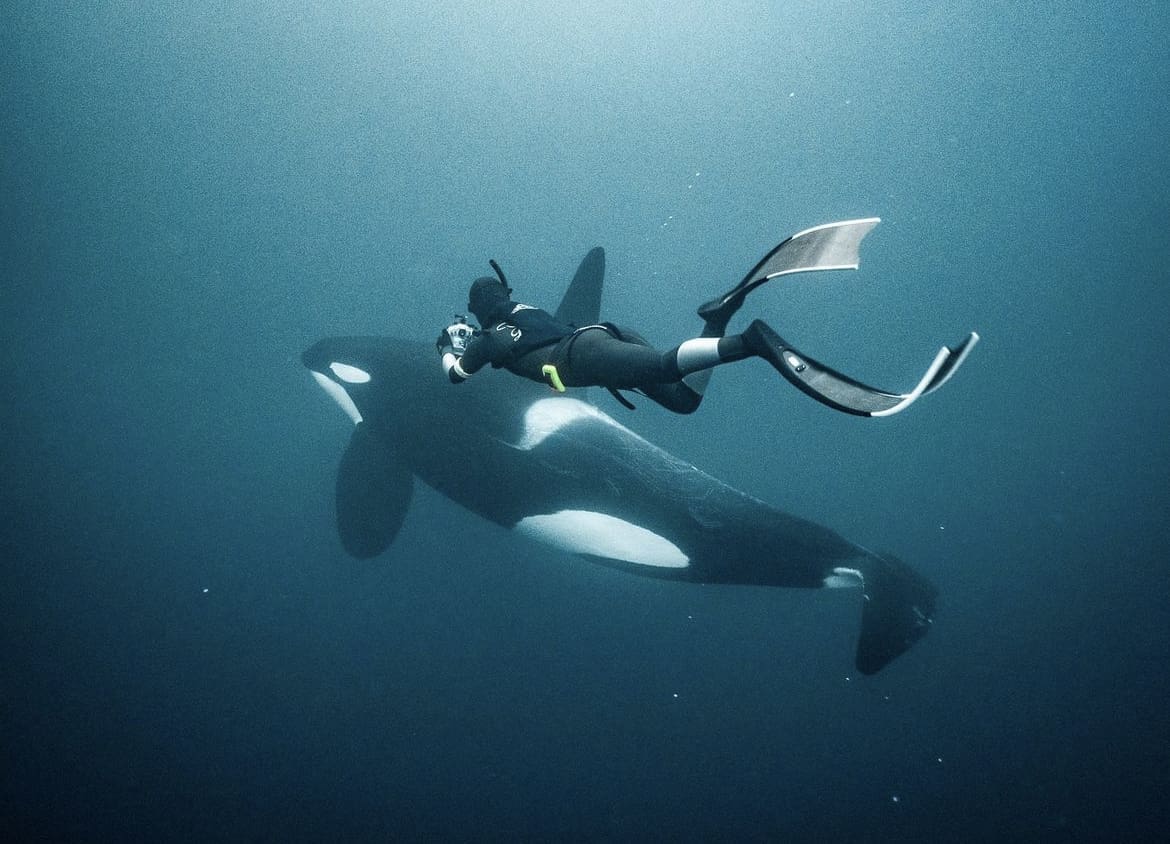
Threats to Orcas in the wild
Orcas face several significant threats in the wild, including:
- Chemical Pollution: Contaminants like PCBs accumulate in orcas’ bodies, affecting their immune and reproductive systems.
- Prey Depletion: Overfishing reduces the availability of key prey species, forcing orcas to adapt their diets or face starvation.
- Noise Pollution: Increased ocean noise from shipping, military activities, and oil exploration disrupts orcas’ communication and echolocation abilities.
- Habitat Destruction: Coastal development and climate change can alter or degrade the natural habitats orcas rely on for feeding and breeding.
Addressing these threats requires concerted global effort and policies that prioritize marine conservation and sustainable practices.
Can you dive with Orcas?
While diving directly with orcas is not widely practiced due to the potential risks and ethical considerations, there are places in the world where you can observe these magnificent creatures from boats or even from the shore. Encounters are regulated to ensure the safety of both the orcas and humans, emphasizing respectful distance and minimal disturbance to the animals.
For those seeking to experience the majesty of orcas up close, it’s crucial to choose responsible tour operators that adhere to ethical wildlife viewing standards, ensuring that our admiration does not negatively impact these marine giants.
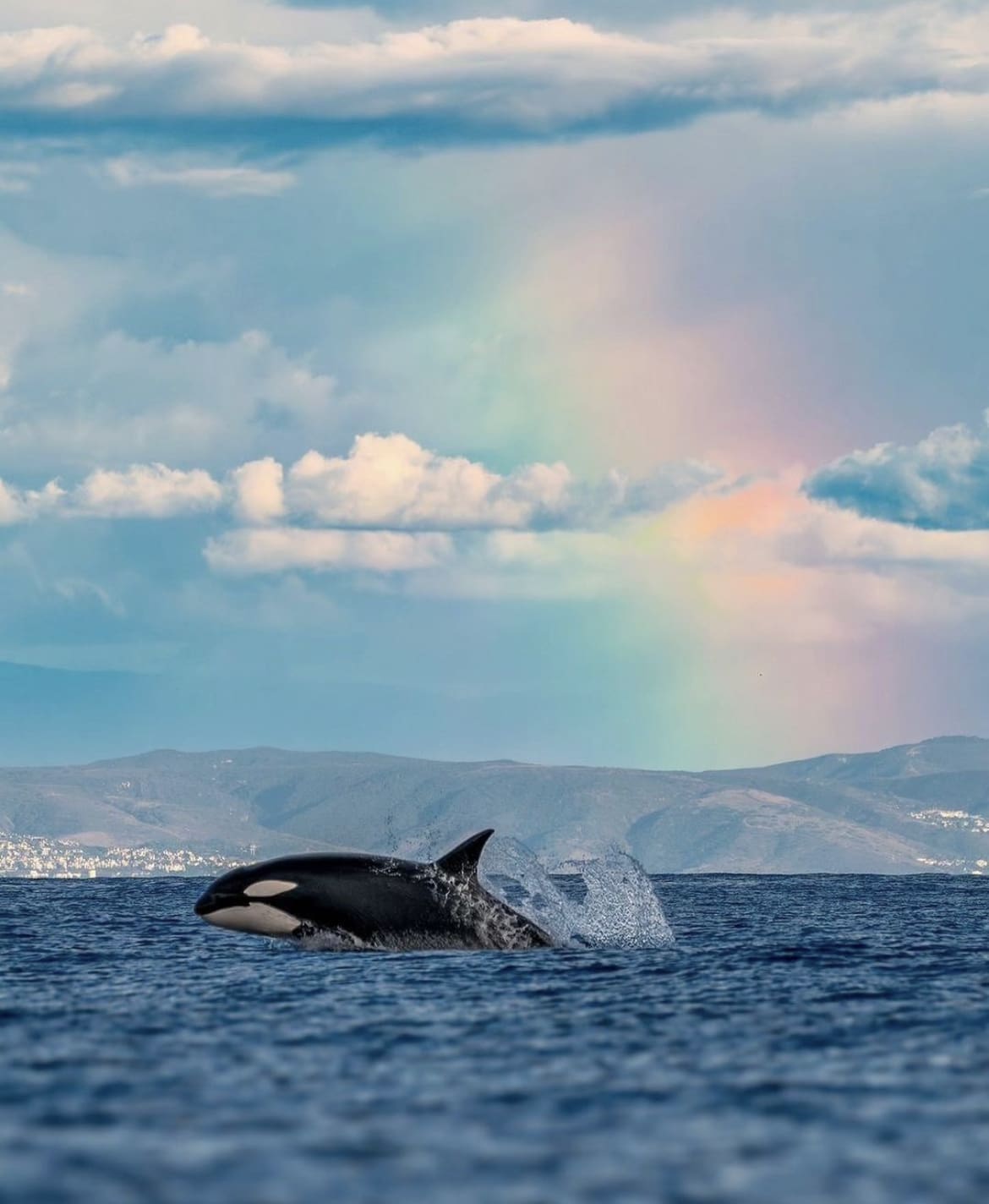
Tips for spotting Orcas in the wild
For those eager to catch a glimpse of orcas in their natural habitat, consider the following tips:
- Research Prime Locations: Certain areas are known hotspots for orca activity, including the waters off the coast of British Columbia, Norway, and New Zealand.
- Time Your Visit: Orcas have seasonal patterns depending on the region, so plan your visit during peak times for a better chance of sightings.
- Respect Wildlife Guidelines: Always maintain a safe and respectful distance. Use binoculars for a closer look without disturbing them.
- Stay Patient: Wildlife viewing requires patience. Spend ample time in known orca territories for a higher chance of spotting them.
Facts about The Orca
- Orcas are found in every ocean, making them one of the most widespread marine mammals.
- They can consume up to 5% of their body weight in food per day.
- Orcas have been known to teach each other new hunting techniques.
- They use complex vocalizations for communication and hunting, with dialects unique to each pod.
Myths about The Killer Whale
- Myth: Orcas are a threat to humans. Reality: There are no documented cases of wild orcas fatally attacking humans.
- Myth: All orcas are the same. Reality: There are several distinct ecotypes of orcas with different diets, behaviors, and social structures.
- Myth: Orcas can be safely kept in captivity. Reality: Captivity often leads to physical and psychological issues for these highly intelligent and social beings.
